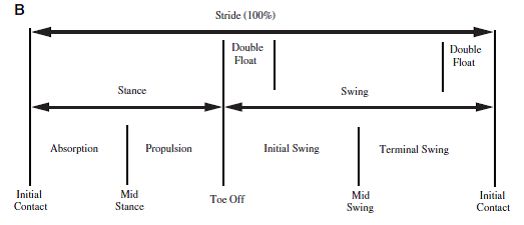Running Biomechanics
Original Editor - Your name will be added here if you created the original content for this page.
Top Contributors - Joanne Garvey, Kapil Narale, Evan Thomas, George Prudden, WikiSysop, Wanda van Niekerk and Naomi O'Reilly
The Running Cycle[edit | edit source]
Running is similar to walking in terms of locomotor activity. However, there are key differences. Having the ability to walk does not been that the individual has the ability to run.
Running requires:
- Greater balance
- Greater muscle strength
- Greater joint range of movement
There is a need for greater balance because the double support period present in walking is not present when running. There is also the addition of a double float period during which both feet are off the ground, not making contact with the support surface.
The amount of time that the runner spends in float, increases as the runner increases in speed. The muscles must produce greater energy to elevate the head, arms and trunk (HAT) higher than in normal walking, and to support HAT during the gait cycle. The muscles and joints, must also be able to absorb increased amounts of energy to control the weight of HAT.
During the running gait cycle, the Ground reaction force (GRF) at the centre of pressure(COP) have been shown to increase to 250% of the body weight.[1]
Sub Heading 2[edit | edit source]
Sub Heading 3[edit | edit source]
Recent Related Research (from Pubmed)[edit | edit source]
Extension:RSS -- Error: Not a valid URL: Feed goes here!!|charset=UTF-8|short|max=10
References[edit | edit source]
References will automatically be added here, see adding references tutorial.
- ↑ Mann RA: Biomechanics of running. In D' Ambrosia, RD and Drez D: Prevention and treatment of running injuries, ed 2. Slack, New Jersey, 1989







